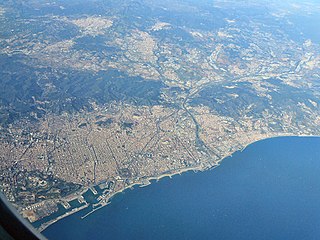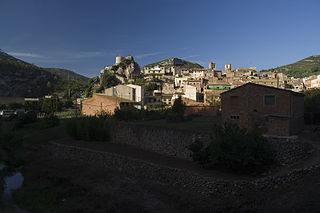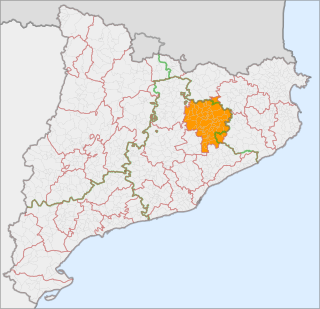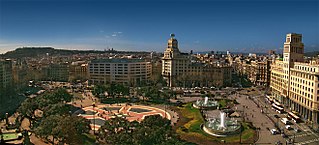
Alta Ribagorça is one of the comarques of Catalonia, Spain. Its capital is Pont de Suert. The highest peak is the Comaloformo in the massif of Bessiberri. Northeast of the region is the western part of the Aigüestortes i Estany de Sant Maurici National Park. It is connected with the Aran valley thorough the Vielha tunnel.

Barcelona is a province of eastern Spain, in the center of the autonomous community of Catalonia. The province is bordered by the provinces of Tarragona, Lleida, and Girona, and by the Mediterranean Sea. Its area is 7,726 km2 (2,983 sq mi). 5,743,402 people live in the province, of whom about 29% (1,664,182) live within the administrative limits of the city of Barcelona, which itself is contained in the Barcelona metropolitan area.

Priorat is a comarca (county) in Catalonia, Spain. The central part of the comarca, "Priorat històric," produces the highly regarded wines that are certified under the DOQ Priorat. Wines from elsewhere in the comarca are certified as DO Montsant although this region also has a small segment of the neighboring comarca, Ribera d'Ebre as well. However, galena mining was the main activity since prehistoric times until 1972, when the last galena mine closed.

Terra Alta is a sparsely populated inland comarca (county) in Catalonia, Spain. Its capital is Gandesa. It is also known as Castellania, a name dating back to its medieval status as a fiefdom held by the Order of Knights of the Hospital of St. John of Jerusalem under the Crown of Aragon.

Pratdip is a municipality in the comarca of Baix Camp, in the province of Tarragona, Catalonia, Spain.

Alt Camp is a comarca (county) in Catalonia, Spain. It is one of the three comarques into which Camp de Tarragona was divided in the comarcal division of 1936.

Conca de Barberà is a comarca (county) in the province of Tarragona, Catalonia, Spain. Its total area is 650.24 km2 (251.1 sq mi). At its creation in 1936, it contained 23 municipalities, but in 1990, several of these were amalgamated; Rojals was combined with Montblanc, and Montbrió de la Marca was amalgamated with Sarral. Also in 1990, Vallfogona de Riucorb was moved from the Segarra comarca. This resulted in the current total of 22 municipalities.

Garraf, better known as El Garraf, is a comarca (county) in the province of Barcelona, Catalonia, northern Spain. It is named after the Garraf Massif.

Les Garrigues is a comarca (county) in Catalonia, Spain. Its capital is Les Borges Blanques. Its symbol is an olive branch, Les Garrigues being the center of olive cultivation in all of Catalonia.

Osona is a comarca situated in Catalonia, Northeast Spain. Its capital is Vic. Its population in 2001 was 129,543. Osona covers roughly the same area as the historic Catalan county of Osona. The name Osona comes from Ausetans, a group of Iberian people who had their capital in Ausa ; the Romans called the area Ausone or Ausona. While most of the comarca is within the province of Barcelona, the municipalities of Espinelves, Vidrà and Viladrau form part of the province of Girona.

The Open University of Catalonia is a private open university based in Barcelona, Spain.

Eix Transversal, labelled C-25, is a primary highway in Catalonia, Spain. It crosses the Catalan Transversal Range mountainous region, connecting the northern end of the Catalan Coastal Depression with the Catalan Central Depression.

Plaça de Catalunya is a large square in central Barcelona that is generally considered to be both its city centre and the place where the old city and the 19th century-built Eixample meet.

The Barcelona–Vallès Line is an unconnected standard gauge rapid transit and commuter railway line linking Barcelona with Sabadell and Terrassa via the Collserola mountain range, in Catalonia, Spain. Its name refers to the Catalan historical region of Vallès, whereby most part of the line runs. Plaça de Catalunya station serves as the Barcelona terminus of the line, where almost all its trains either start or terminate. The line then continues northwards and branches off twice before leaving the city limits. Its main route splits in two in Sant Cugat del Vallès, forming two major branches to Sabadell and Terrassa. It has 40 passenger stations in operation and a total line length of 48.1 kilometres (29.9 mi).

Lleida Pirineus is an important railway station serving the city of Lleida in Catalonia, Spain. It is located between the neighbourhoods of Pardinyes and Rambla de Ferran. The first train services in Lleida date of 1860, but the station wasn't built until 1927, and it did not adopt its current official name until 2003, when it underwent an ambitious reform. As a transport hub connecting the interior of Spain with the Corredor Mediterráneo, it serves both broad gauge and standard gauge trains, operated by both Adif-Renfe and Ferrocarrils de la Generalitat de Catalunya. It is the terminus of several regional railway services centered in Aragon and Catalonia. It's also one of the stations on the Madrid–Barcelona high-speed rail line, and it was its north-eastern terminus until 2008.

Dreta de l'Eixample is a neighborhood in the Eixample district of Barcelona, Catalonia (Spain). It is located east of Carrer de Balmes. It includes Plaça de Catalunya, the centre of the city, and the upscale streets Rambla de Catalunya and Passeig de Gràcia. It is the bourgeois neighborhood of the city, which makes the majority of its population belong to the upper class of Barcelona. Dreta de L'Eixample is one of the most luxurious neighborhoods of Barcelona.

The University of Lleida is a university based in Lleida, Catalonia, Spain. It was the first university founded in Catalonia and in the ancient Crown of Aragon. It was founded in 1300, using the name of Estudi General de Lleida.

The Catalan Coastal Depression, Catalan: Depressió Litoral Catalana, is a natural depression between the Catalan Pre-Coastal Range and the Mediterranean Sea. It is part of the Catalan Mediterranean System.

The Catalan Transversal Range is a system of minor mountain ranges at the eastern end of the Pre-Pyrenees, between the Osona and Garrotxa comarques. The existence of the Catalan Transversal Range has made communications in the northern areas of Catalonia difficult in the past, especially between Northeastern Catalonia and Western Catalonia, a problem that has been partly solved with the development of the Eix Transversal.

The Catalan Mediterranean System, also known as Mediterranean System, Transversal Ibero-Pyrenaean System, and Catalanid System, is a wide coastal geographical region in Catalonia. It is made up of a double system of coastal mountain chains: The Catalan Coastal Range and the Catalan Pre-Coastal Range, as well as the Catalan Coastal Depression and other coastal and pre-coastal plains located among those mountain ranges.


















